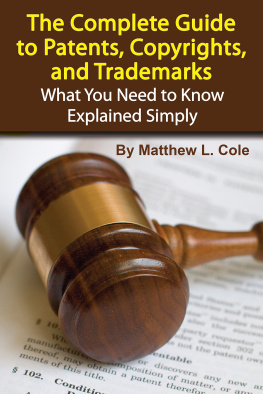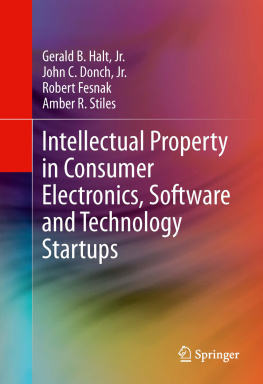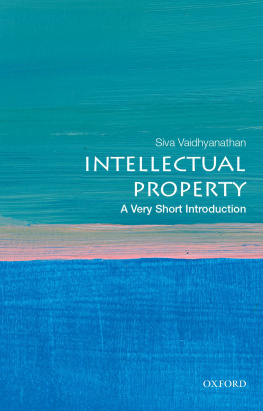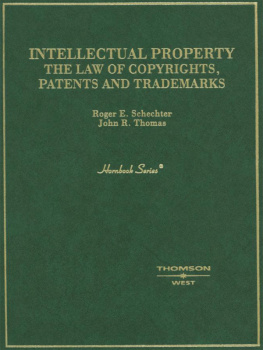PAUL SUMPTER holds a senior academic position in the Faculty of Law at the University of Auckland where he teaches undergraduate and postgraduate intellectual property law. He also teaches a biotechnology intellectual property law course for post-graduate science students. Paul is a barrister and solicitor and a registered patent attorney.
He is concurrently a consultant with Chapman Tripp and has more than 30 years experience advising clients in all aspects of intellectual property, including trade mark conflicts, copyright infringement, trade secrets, patents and licensing.
Paul was appointed to the Copyright Tribunal of New Zealand in 2004. He also serves on the Trans-Tasman committee of the Intellectual Property Society of New Zealand and Australia (IPSANZ), is a member of the New Zealand Law Society (NZLS) committee for IP legislation issues and a Fellow of the New Zealand Institute of Patent Attorneys.
INTELLECTUAL PROPERTY IN NEW ZEALAND
A Users Guide to Copyright, Patents, Trade Marks and More
PAUL SUMPTER

Contents
Preface and acknowledgements
I have been teaching and practising intellectual property law for longer than I care to remember. This book is, therefore, based upon my reading, practical experience and lecture notes over a long period of time. It is aimed squarely at non-lawyers, and I hope that it will enable people without legal training to gain an understanding of intellectual property and the laws that protect it. That means that I have attempted to make the law simple.
In doing so, however, there were dangers, and writing the book proved to be challenging. I have had to make a number of generalisations. The law is a detail-rich subject, notorious for its shades of grey, and it is in these nuances, often, that judges make decisions by applying particular facts to particular law. So the book is certainly not a substitute for legal advice. Hopefully, however, it will help to explain the law in a way that might be useful to people in all walks of life.
I have borrowed from my textbook Intellectual Property Law Principles in Practice, published by CCH New Zealand. That book itself derived assistance from other textbook writers and is replete with footnotes, acknowledging the source of ideas, specific quotations or cases. For example, the very brief references to the history of brands in this book may be traced, in part, to an article by T. D. Drescher (The Transformation and Evolution of Trade Marks: From Signals to Symbols to Myth) in the Trade Mark Reporter in 1992. Of all the textbooks I have consulted the most valuable has been an English one, first published solely by Professor Bill Cornish (Cambridge University) but lately with two co-authors, Intellectual Property: Patents, Copyright, Trade Marks and AlliedRights. There have been numerous other books and articles into which I have dipped from time to time. Then there are, of course, the New Zealand statutes themselves and, most importantly, the judgments of the New Zealand and overseas courts. Further references can be found in the short bibliography.
I wish to acknowledge the critical but helpful appraisal of drafts of this book by Sam Elworthy of Auckland University Press and the independent reviewers. I also thank the editorial team at Auckland University Press, Anna Hodge, Fiona Kirkcaldie as well as the word-processing team at Chapman Tripp.
Disclaimer: Under no circumstances should this book be resorted to as a substitute for obtaining professional legal advice. The book has been written, edited and published and is sold on the basis that all parties involved in the publication exclude any liability, including in negligence or defamation, for all or any damages or liability in respect of or arising out of the use, reliance or otherwise of this book.
Introduction
What is intellectual property?
Not long ago, intellectual property was a fairly mysterious subject to many people. A relatively small group of lawyers specialised in IP law, and patent attorneys dealt with patents and trade marks. But towards the end of the twentieth century, the phrase started to gain traction and began cropping up in media reports. These days the term intellectual property or IP is almost as likely to be heard on talk-back radio as it is at law school. The impact of digital technology and the Internet and the growing economic importance of intellectual property laws have undoubtedly been pivotal to the rise in mainstream awareness of this area of the law.
Intellectual property laws are said to be protections for creations of the human mind. Usually these protections are bestowed by laws passed through Parliament (known as statutes or legislation). However, judges in the courts have also created some of the law over a long period of time generally in England (this type of law is called common law).
The main IP laws are:
trade marks, which protect brand identity, covered in the chapter entitled Brands;
inventions covered by a patent, dealt with in the chapter entitled Patents;
Copyright, which deals with a vast array of items and provides broad-brush protection for a particular creative output but not the ideas contained within it.
These three areas are covered by specific statutes (and brands have additional common law protection). They are characterised, as the umbrella name suggests, by the fact that they give rise to property rights. This property is not of course physical; it is intangible.
A fourth key IP law is the protection of undisclosed Confidential information. This is not really a property right and nor is there a specific statute that deals with it.
In addition there are a raft of less commonly encountered laws, in some cases closely linked to the laws above. These include laws about registered designs, plant variety rights, geographical indications and certain cultural protections sought by indigenous people such as Mori. These are covered in the chapter entitled A miscellany of intellectual property laws.
Rationale
Why do we have intellectual property laws? One justification is based on the biblical notion of reaping where you have not sown. If someone has come up with a useful idea through time, effort and creative thought then they, and not some copy-cat, should enjoy the fruits of that labour. Sometimes you can still see references to this rationale in the reported cases and certainly there is often talk of defendants having unjustifiably taken a shortcut. There is, in brief, a strong element of fairness in intellectual property law.
A justification more commonly encountered these days is the incentive theory. The premise is that if society bestows on an inventor or creative person some form of monopoly right then that clever person will be encouraged in that activity to everyones ultimate benefit. The key is to have the right balance between, on the one hand, giving rights to the creators and, on the other, ensuring that the public interest is served. This is achieved by factoring in certain limitations and exceptions to exclusive rights in intellectual property law.
International context
Intellectual property law is rooted in English and later New Zealand statute and common law. But it also has a wider international context. In the nineteenth century states began to recognise that they needed to co-operate with one another about these laws. In 1883 the Paris Convention was set up in relation to a range of protections but in particular patents and trade marks. The Berne Convention was signed in 1886, establishing a multi-national system of reciprocity of rights in copyright. Today, the Agreement on Trade-Related Aspects of Intellectual Property Rights (TRIPS) is the international gold standard. Conceived in the early 1990s, it was signed in 1994 (New Zealand was an initial signatory) and required any country wishing to join the new World Trade Organization (WTO) to comply with minimum standards to protect intellectual property. If countries wished to enjoy the benefits of free trade that it was hoped membership of the WTO would provide, the argument went, then they should have strong laws for patents, trade marks, copyright and other rights.












